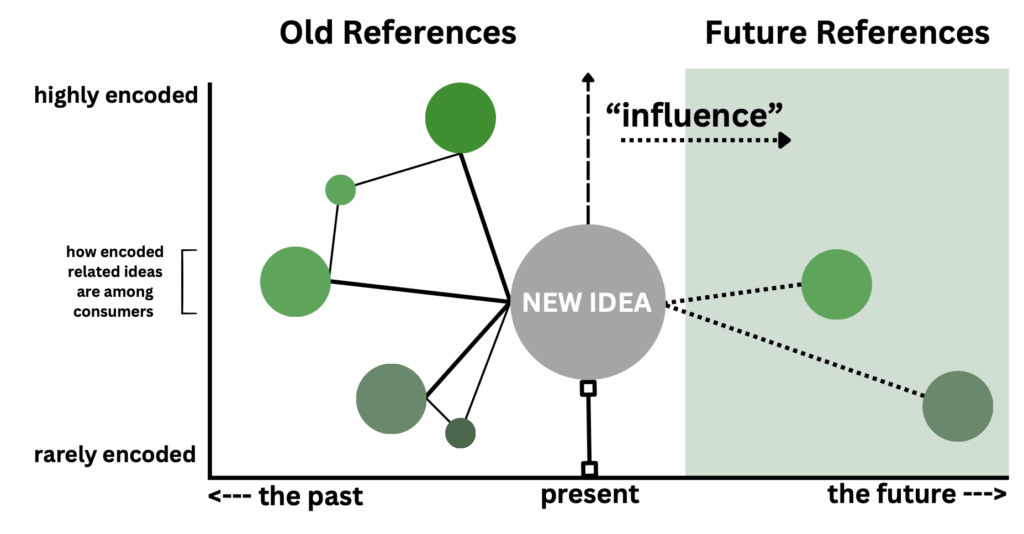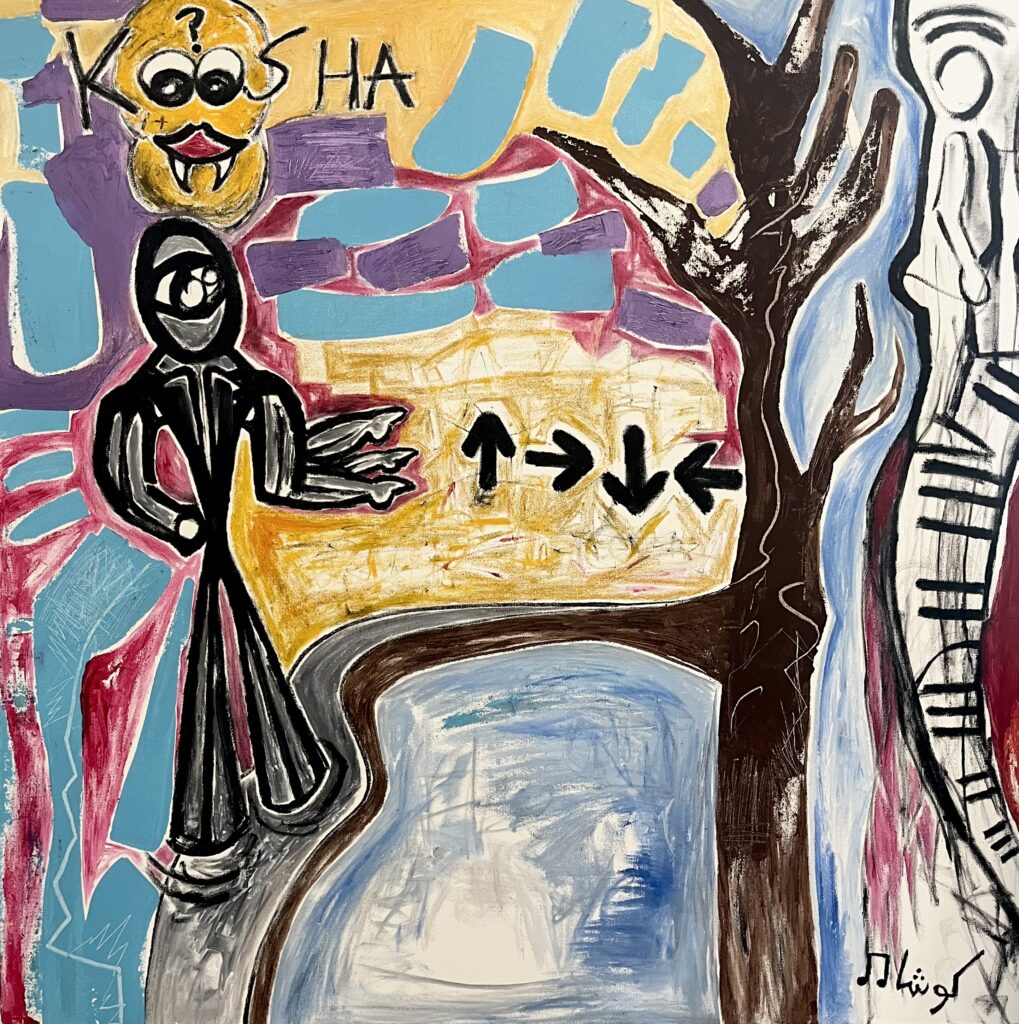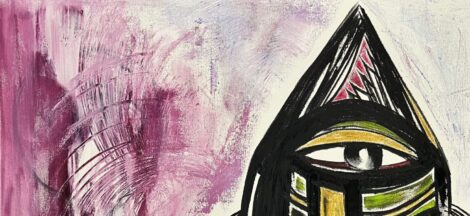Making it as a creator is difficult, an upward climb. No one immediately cares about your contributions to the collective until there is a reason to do so. For consumers, there is no incentive to adopt new things just for the sake of their newness. Something new demands its place and integrity within an environment where all the current forces coexist well and comfortably.
This is why it is worth investigating how things encode themselves within a culture and the minds of consumers. Information is abundant, but the things we consider noteworthy only decrease over time. So how do some things escape the noise and become part of our cultural language? How can artists or innovators increase the likelihood of their creation’s stickiness to culture?
References
So how do some things escape the noise and become part of our cultural language?
The answer depends on the necessity of such a work, its connection to our past and future, and some luck with timing. Here, I primarily discuss the second point which is rooted in context.
Context matters. You hear that sh*t everywhere.
Virgil Abloh‘s take on designing “the room” vs the object in the space expresses what I mean by references providing value and a story to the idea or subject.
The context of the work, the context of its broader movement, and the context of the world matters.
References provide divots in the greater context that consumers can hold on to. They make new ideas stick more to our developing taste buds.
New things that are adopted widely tend to be rich in references – like the Wikipedia page of your favorite author. The page is decorated with references to other pages of related ideas that you have likely been exposed to or will be curious about in the future. Wikipedia, by nature, makes these relationships between ideas transparent. However, typically, references are invisible to us upon first contact with a new concept or product. When blatantly obvious or done in poor taste, relying on references can be a turn-off. Especially when you rip something off or ruin something that is already great.
The relationship between the new thing and its surrounding things helps define its place in the world. Hyperlinking ideas – new and old – within a new item that feels grounded is how you, as a creator, integrate your idea into the collective conscience through the path of least resistance.
Generally, consumers can’t resist what is familiar yet fresh.
Relationships between ideas
Search engines on the Internet tend to index webpages with more inbound links higher than those with fewer or weaker links. This system heavily values inbound references or backlinks. As human computers, we operate similarly. To no great surprise, technology mimics our internal operations and provides evidence of human footprints.
We remember information based on its relationship with other bits of information and through a filter of biological faculties that assign additional sensory information to the content. The world’s media has never been this fluid and prone to mutation. Things that feel familiar get adopted quickly and mutate through algorithms that propel that idea up and wide, attaching it to broader aesthetics and subconscious mood boards.
Conforming with a pre-existing distribution channel will help you get seen. But it won’t guarantee that your contribution is distinguishable from the noise.
People remix and reuse the aesthetic and/or symbolic properties of an idea. Everything turns into a meme. People can interact with an idea and share it in a new format. It can go from high art to fast food content or vice versa depending on the situation.
New things that join the culture fill gaps in the broader world of a thing, genre, or field. They fit into a specific timeline (or progression) of ideas and validate the pre-conceived senses of a thing of that caliber. In other words, they are likely meta or zeitgeisty.
New ideas insert themselves between a past where an established culture with defined networks of ideas shapes a future network of ideas built on the existing web. A new addition to this network becomes more encoded in people’s minds when old references to this item are highly encoded or relevant. Similar to how webpages backlink to each other on relevant themes or contexts.
This relationship between the past and present is often semiotic: subtle symbolic connections allow us to attach meaning to what’s new. Older ideas pass on their meaning, swagger, or cultural fuel. Suddenly, the new thing becomes riveting or at best, here to stay in people’s minds and these semiotic systems in the background.

The figure above maps ideas referencing one another between the past and future. Ideas that are highly encoded are the ideas that people think about very often or use in their cultural vocabulary. These ideas pass on more power to the new idea to help it become more encoded in people’s minds. Influence occurs when one idea serves as a reference to future things.
When you break the rules
When you make something new that isn’t rich in references and stands alone, you fight an uphill adoption battle. The creator can try to spark a revolution, but broader cultural shifts or narrative transitions are often required to enable such a thing to integrate well with the audience’s taste.
Ultimately, new things need some pre-existing idea, theme, or reference to latch on to. A sample in a song or production credit can go a long way in orienting the new work as an addition to an ongoing chain of works. The easier you allow people to get what you’re doing and what you’re contributing based on previous knowledge, the quicker adoption occurs and the wider the creation spreads.
In music, artists who pair their abstract songs with some form of visuals turn their song into a larger concept with more references (now with a visual dimension) which increases the likelihood of interest or at least understanding in audiences.
When you have something weird or abstract in front of you, any additional reference or dimension can help position the work as something greater or clearer than before.
Blindness as a feature
Sometimes the audience’s blindness to nuance and pre-existing context can be a feature. The Google search required to get what the artist is really about can be priceless. Artists who spark rabbit holes are awesome.
Part of an idea’s purpose could rely on a mysterious personality or lack of immediate information that delays the audience’s encoding process of the work. We provide space for these things in our minds without understanding the core features right away. Patience and investment in such nuance make consumption more intentional and may bring one closer to the work.
Mystery attached to the right medium can be refreshing for the space in which the idea permeates. In the wrong context, it can come off as lazy, pretentious, or rid of human touch.
Memetic properties
Let’s talk about memetic properties – how understandable, shareable, and relatable something is. Simple things tend to be understood with ease. They also can be easier to share due to their innate lack of complexity. Further, people can relate to simple things and make that thing part of their life much easier than something personal or abstract.
Something rich in references also tends to have other memetic properties. References train the audience’s subconscious mind to accept the new thing given that it follows similar patterns found in prior works. People are likely to share and internalize things that build on their previous understanding of other things they care about.
Our minds constantly take in new information to construct a story about the day and our lives. We use media to help paint a picture for our stories and to create subconscious time capsules of the period we are in.
We are not strategic with these stories; our minds pick up on the simple songs played in the club during ‘that one night’ or the entertainers acting in our favorite shows. Some go out of their way to consume abstract content – satirical or avant-garde – to train a more esoteric storyline. But we can’t escape how easily certain things integrate with our mind chatter.
Simple things that are repeatedly shown or played in front of you will sneak into the psyche. They are memetic (like memes).
They are 30-second audio clips on TikTok, funny new slang phrases, and even stereotypes.
The Taylor Swift fan
Speaking of Swifties – it is perhaps by coincidence or product of simple statistics that makes one a Taylor Swift fan. Being her fan is easy, so people tend to do it.
The simple themes and relatable stories of her music become an extension of the consumer’s immediate life and potentially influence other consumption habits.
Seeing each song, video, meme, or film as a new node entering a robust network of other works enables a greater understanding of consumption. Sometimes, we can pinpoint how a single song, chorus, or lyric influences a consumer’s will to live or will to purchase certain clothing.
Taylor’s work is one with the kids and their simple naive arguments for why something occurred. There is no trick in the messaging. Swifties are fed a metaphorical warm chicken soup on a cold day but without any spices or things that’ll make the consumption any bit introspective; their taste for normal stuff and easy material powers Taylor’s empire.
Miscellaneous thoughts
Some advice to creators:
Touch on the past in a clever way that isn’t too obvious or a poor cosplay of something people cherish. Sprinkle language that is familiar to the public. Begin by understanding what pre-existing works are out there (identify the norms then create a baseline for quality and communication) and then dismantle parts of the creative norms to reconstruct a new way of expressing that is fresh yet alluding to a rich past of evolving ideas.
If you like to be a mysterious artist, remember that you are giving the audience less data to work with. The viewers and listeners must have enough context to construct a version of your story in their heads.
The story’s precision depends on where the consumer lives, what the consumer’s norms are, and what prior exposure they have to similar works.
Think about how an average hip-hop fan from Tehran may look at Kanye West as opposed to a Chicago native. How do civilians digest Banksy’s murals in Gaza as opposed to the United Kingdom’s bourgeois?
Each demographic constructs these stories differently, but the shared forum of social media could dilute the uniqueness of each perspective.
Here, social media breaks the news, spreads the idea, and inherently biases the narrative to fit the interest of the algorithm and the account spreading information.
Culture as continental shift (yet another metaphor)
The world’s cultural landscape mimics continental shift.
Beginning at Pangea, where ideas exist in one clustered core center and slowly disperse to new coordinates where unique physical and metaphysical properties develop.
With all this culture and all these artifacts spread across the lands, you’d think that the world is vast. But the internet has truly changed this perception of vastness and our access to ideas.
Our civilization spent thousands of years evolving and now we can tap into the collective hivemind by projecting a sticky idea onto an internet community.
Most people live within the cultural landscape’s foreground, absorbing the fresh produce of the culture industry. Most are consumers of generic commercial products.
But going behind the scenes and exploring the underground is fruitful and more honest. The easiest way to see what exists beyond the foreground (that is fed to you) is to create something great or identify the real players in an industry. Understand that only a sliver of the human experience is captured by the creators promoted by the system.
So much is left to be desired, felt, and communicated.
Meet other creators who share the struggle of creating something from their bedroom. Meet others who see culture as this domesticated beast chained to the iPhone.
Most people with ample time and energy have the key to making something that sticks and pushes the culture forward. A specific vision or curation of existing energies helps the process.
My goal with this writing is to reveal several invisible forces. By emphasizing references and relationships between ideas, I hope I have explained things in a digestible way.



 Mecca as a Non-believer: Reflections on My Introspective Experience
Mecca as a Non-believer: Reflections on My Introspective Experience